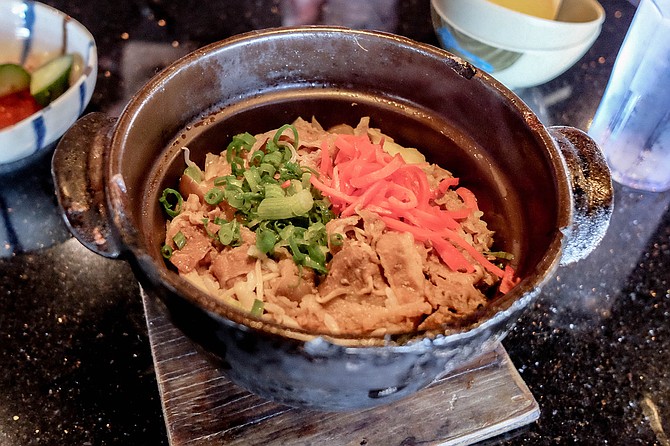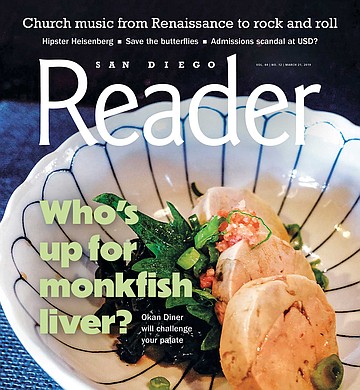 Facebook
Facebook
 X
X
 Instagram
Instagram
 TikTok
TikTok
 Youtube
Youtube

The name of the restaurant may include the word diner, but don’t go expecting to order a Denver omelet, or anything with a side of hash browns. Okan Diner serves Japanese food, and a fair amount of it. So far reaching are the dishes that we decided to get experimental.

“We’re going to try the ankimo, please.”
That’s the $7 appetizer of steamed monkfish liver, little pâté patties of it, served with ponzu, seaweed, and shiso leaf. Don’t worry, the rest of our meal was far less challenging to the American palate. Japanese is my all-time favorite cuisine, but fishy liver paste isn’t what makes it so.
But we were not deterred. The menu goes on for pages, with pictures, featuring everything from udon and ramen to fried food and sushi. A second appetizer, the $4 Ume-Q, consisted of cucumber chunks in a spicy, salty plum sauce, topped with bonito flakes. Mostly, we ordered this to squeeze in a vegetable dish, but this challenging combination of flavors proved far more exciting than I would have expected from any cucumber salad.
From the yakitori menu we skipped chicken gizzards, ribeye, and pork belly to try the freshwater eel. It was pretty much identical to unagi of sushi restaurants, except with a hint of char that made it even better. We happily chewed on savory gesso karaage: fried squid legs.

But the real reason for being here was to try kamameshi. A rare enough find in San Diego, in English it would be called “kettle rice.” We actually ordered this one first, because it takes 20 minutes to prepare. The rice cooks with broth inside the kama (kettle), yielding a flavored, single pot rice dish topped with meat, fish, and/or vegetables.
At $15 apiece, Okan serves a varied assortment of kamameshi. One features salmon and salmon roe; another chicken, mushrooms and quail egg; a third, made with tonkotsu ramen broth, features kakuni pork belly and poached egg. Our choice was sukiyaki beef flavored with gobo root and pickled ginger.
“This is definitely comfort food,” said my friend across the table, somehow finding a moment to do so between bites.

He got no argument from me. The ginger offered the dish’s most pronounced spice; the shaved ribeye sukiyaki, contributed pleasing umami to a very mild gobo sweetness. It’s not a dish that grabs you by the mouth with salt and fat, rather it ratchets up the pleasure with each bite, until you’re scraping the bottom of the kettle, unready to relinquish the nuanced enjoyment. We’d ordered the kettle to share, and silently rued one another for it.

Okan Diner offers a menu similar to but larger than sister restaurant Wa Dining Okan, and I get the feeling I could eat a dozen wholly satisfying meals here without ever seeing the same dish twice, or failing to experience something new, whether an unfamiliar ingredient, or unimagined combination of flavors.
I don’t think I could ask more of any restaurant than that.


The name of the restaurant may include the word diner, but don’t go expecting to order a Denver omelet, or anything with a side of hash browns. Okan Diner serves Japanese food, and a fair amount of it. So far reaching are the dishes that we decided to get experimental.

“We’re going to try the ankimo, please.”
That’s the $7 appetizer of steamed monkfish liver, little pâté patties of it, served with ponzu, seaweed, and shiso leaf. Don’t worry, the rest of our meal was far less challenging to the American palate. Japanese is my all-time favorite cuisine, but fishy liver paste isn’t what makes it so.
But we were not deterred. The menu goes on for pages, with pictures, featuring everything from udon and ramen to fried food and sushi. A second appetizer, the $4 Ume-Q, consisted of cucumber chunks in a spicy, salty plum sauce, topped with bonito flakes. Mostly, we ordered this to squeeze in a vegetable dish, but this challenging combination of flavors proved far more exciting than I would have expected from any cucumber salad.
From the yakitori menu we skipped chicken gizzards, ribeye, and pork belly to try the freshwater eel. It was pretty much identical to unagi of sushi restaurants, except with a hint of char that made it even better. We happily chewed on savory gesso karaage: fried squid legs.

But the real reason for being here was to try kamameshi. A rare enough find in San Diego, in English it would be called “kettle rice.” We actually ordered this one first, because it takes 20 minutes to prepare. The rice cooks with broth inside the kama (kettle), yielding a flavored, single pot rice dish topped with meat, fish, and/or vegetables.
At $15 apiece, Okan serves a varied assortment of kamameshi. One features salmon and salmon roe; another chicken, mushrooms and quail egg; a third, made with tonkotsu ramen broth, features kakuni pork belly and poached egg. Our choice was sukiyaki beef flavored with gobo root and pickled ginger.
“This is definitely comfort food,” said my friend across the table, somehow finding a moment to do so between bites.

He got no argument from me. The ginger offered the dish’s most pronounced spice; the shaved ribeye sukiyaki, contributed pleasing umami to a very mild gobo sweetness. It’s not a dish that grabs you by the mouth with salt and fat, rather it ratchets up the pleasure with each bite, until you’re scraping the bottom of the kettle, unready to relinquish the nuanced enjoyment. We’d ordered the kettle to share, and silently rued one another for it.

Okan Diner offers a menu similar to but larger than sister restaurant Wa Dining Okan, and I get the feeling I could eat a dozen wholly satisfying meals here without ever seeing the same dish twice, or failing to experience something new, whether an unfamiliar ingredient, or unimagined combination of flavors.
I don’t think I could ask more of any restaurant than that.